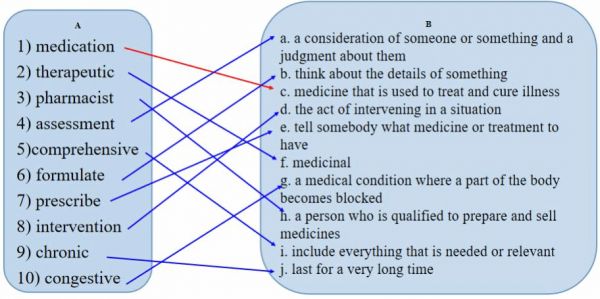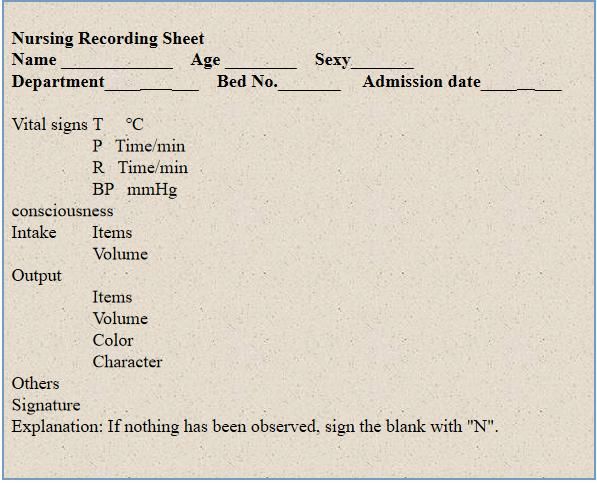护理学院《Nursing English》课程思政教学案例
育人目标
1.通过贯穿“倡导健康的生活理念和生活方式,进一步提高公众药品安全科学素养”的理念和目标,培养护生生命至上、安全用药的职业精神,形成维护和促进人类健康为己任的专业价值观和社会责任感(思政目标),帮助学生学习并掌握药物管理的相关知识(教学目标),体现人道主义精神和全心全意为全人类服务的专业精神,将专业价值观渗透到课程教学中,提高民众安全用药的科学素养以及健康生活的理念共识。
2.通过案例教学设计,帮助学生感受药物管理过程中,护士维护和促进人类健康的重要性,培养护生生命至上、安全用药的职业精神,形成维护和促进人类健康为己任的专业价值观和社会责任感(思政目标),帮助学生学习并掌握药物管理的相关知识(教学目标),激发学生学好理论知识和技能的信念,帮助学生坚定从事护理/助产职业的信心,为病人提供药品安全宣传教育、咨询指导、筛查评估、综合干预和应急救治等全方位卫生健康服务,提高全人类健康水平和人均健康预期寿命,凝聚共筑药品安全的社会共识,为实现中华民族伟大复兴的中国梦而不懈奋斗。
3.通过线上线下、多元化的教学形式和方法的应用,将充满正能量的主流价值观传递给学生,将科学育人与学科育人相结合,将护士使命感与助产专业价值观相结合,在潜移默化中实现育人效果的知行合一、内化于心、外化于行。
二、Coherent teaching content (40 minutes)
Class Activities:
1.Vocabulary Study
1.1 Match the words in column A with the definitions in column B.

1.2 Fill in the blanks with the words learned above. Make changes if necessary.
(1)The physician examines the patient then diagnoses the disease and prescribes medications.
(2)What we should do is that we would then perform an intervention.
(3)People lived shorter lives so they didn't get far enough to suffer from the chronic diseases that people are suffering more today.
(4)She suffered congestive heart failure and spent weeks in the hospital.
(5)Some patients in therapy want to learn to find satisfaction in what they do.
(6)You need to assess all risks to determine if the operation are within acceptable level of risk.
(7)Bed rest is the best prescription for back pain.
(8)We have ample reason to conclude that chronic anger is bad for us.
2.Focus on reading I
Medication therapy management (MTM) is medical care provided by pharmacists whose aim is to optimize drug therapy and improve therapeutic outcomes for patients. Eleven national pharmacy organizations adopted this definition in 2004. Medication therapy management includes a broad range of professional activities, including but not limited to performing patient assessment and a comprehensive medication review, formulating a medication treatment plan, monitoring efficacy and safety of medication therapy, enhancing medication adherence through patient empowerment and education, and documenting and communicating MTM services to prescribers in order to maintain comprehensive patient care.
Medication therapy management includes five core components: a medication therapy review (MTR), personal medication record (PMR), medication-related action plan (MAP), intervention and/or referral, and documentation and follow-up. A MTR is a systematic process of collecting patient and medication-related information which occurs during the pharmacist-patient encounter. In addition, the MTR assists in the identification and prioritization of medication-related problems. During the MTM encounter, the pharmacist develops a PMR for use by the patient. The PMR includes all prescription and nonprescription products and requires updating as necessary. After assessing and identifying medication-related problems, the pharmacist develops a patient-specific MAP. The MAP is a list of self-management actions necessary to achieve the patient’s specific health goals. In addition, the patient and pharmacist utilize the MAP to record actions and track progress towards health goals. During the MTM session, the pharmacist identifies medication-related problems and determines appropriate interventions for resolution. Often, the pharmacist collaborates with other health care professionals to resolve the identified problems. Following the patient encounter and intervention, the pharmacist must document his/her encounter and determine appropriate patient follow-up.
Hepler and Strand define pharmaceutical care as the provision of drug therapy in order to achieve definite outcomes that improve a patient’s quality of life. Outcomes include cure of a disease, elimination or reduction of a patient’s symptomatology, arresting or slowing of a disease process, and preventing a disease or symptomatology. The process includes pharmacist collaboration with other health care professionals in designing, implementing, and monitoring a therapeutic plan for a patient. Pharmaceutical care focuses on the pharmacist’s role in achieving therapeutic goals to improve the patient’s quality of life.
MTM services target beneficiaries who have multiple chronic conditions (such as diabetes, asthma, hypertension, hyperlipidemia, and congestive heart failure), take multiple medications, or are likely to incur annual costs above a predetermined level.
3.Translation
护士:你好!你是史密斯先生吗?·史密斯先生:是的。
护士:现在我给你打一针。·史密斯先生:好的。
护士:我先给你做个皮肤测试,看看你是否过敏。(过了一会儿)
由于您对抗破伤风血清敏感,我们必须给您注射四剂,每隔20分钟注射一次。
先生。史密斯:我应该多久打一次针?
护士:一天一次。
先生。史密斯:你把它放在哪里?
护士:在臀部。
先生。史密斯:我昨天发现屁股上有个肿块。我该怎么办呢?
护士:让我看看。最好用热毛巾敷一下。一天两次,每次15分钟。如果没有好转,我们将尝试物理治疗。
先生。史密斯:非常感谢。
护士:不客气。
4.Focus on reading II
Chinese Herbology(1)
Chinese herbology (simplified Chinese or traditional Chinese) is the theory of traditional Chinese herbal therapy, which accounts for the majority of treatments in traditional Chinese medicine (TCM). The term herbology is misleading in the sense that, while plant elements are by far the most commonly used substances, animal, human, and mineral products are also utilized. Thus, the term "medicinal" (instead of herb) is usually preferred as a translation for yào.
·Raw materials
There are roughly 13,000 medicinals used in China and over 100,000 medicinal recipes recorded in the ancient literature. Plant elements and extracts are by far the most common elements used. In the classic Handbook of Traditional Drugs from 1941, 517 drugs were listed-out of these, only 45 were animal parts, and 30 were minerals. For many plants used as medicinals, detailed instructions have been handed down not only regarding the locations and areas where they grow best, but also regarding the best timing of planting and harvesting them.
Some animal parts used as medicinals can be considered rather strange such as cows' gallstones. Furthermore, the classic materia medica Bencao Gangmu describes the use of 35 traditional Chinese medicines derived from the human body, including bones, fingernail, hairs, dandruff, earwax, impurities on the teeth, feces, urine, sweat, and organs, but most are no longer in use.
·Preparation
Each herbal medicine prescription is a cocktail of many substances, usually tailored to the individual patient. Typically, one batch of medicinals is prepared as a decoction of about 9 to 18 substances. Some of these are considered as main herbs, some as ancillary herbs; within the ancillary herbs, up to three categories can be distinguished. Some ingredients are added in order to cancel out toxicity or side-effects of the main ingredients; on top of that, some medicinals require the use of other substances as catalysts.
Chinese patent medicine are standardized herbal formulas. From ancient times, pills were formed by combining several herbs and other ingredients, which were dried and ground into a powder. They were then mixed with a binder and formed into pills by hand. The binder was traditionally honey. Modern pills, however, are extracted in stainless steel extractors to create either a water decoction or water-alcohol decoction, depending on the herbs used. They are extracted at a low temperature (below 100 degrees Celsius) to preserve essential ingredients. The extracted liquid is then further condensed, and some raw herb powder from one of the herbal ingredients is mixed in to form a herbal dough. This dough is then machine cut into tiny pieces, a small amount of excipients are added for a smooth and consistent exterior, and they are spun into pills. Chinese patent medicines are easy and convenient. They are not easy to customize on a patient-by-patient basis, however. They are often used when a patient's condition is not severe and the medicine can be taken as a long-term treatment.
学习并掌握药物管理的医学术语及相关情境表达,激发学生学好理论知识和技能的信念,帮助学生坚定从事护理/助产职业的信心
坚定从事护理/助产职业的信心,为病人提供药品安全宣传教育、咨询指导、筛查评估、综合干预和应急救治等全方位卫生健康服务,提高全人类健康水平和人均健康预期寿命,凝聚共筑药品安全的社会共识,为实现中华民族伟大复兴的中国梦而不懈奋斗。
培养学生全面、辩证的思维
培养学生坚持不懈、勇于奉献的科学态度,学习老一辈科学家严谨、求真、仁爱、创新的工作态度,增强学生的文化自信
的职业使命感、责任感与艰苦奋斗、开拓进取的科研精神,厚植学生的强烈的爱国情怀
通过《加强重症患者药物治疗全过程的护理管理与监护》的中文文献阅读作为对课堂内容的补充
通过教师设置问题、学生查阅资料进行沟通表达,引导学生积极参与,培养学生的自觉性和主动性,从而有效激励学生学习内动力的产生。
通过《屠呦呦与青蒿素的前世今生》视频,以屠呦呦研究青蒿素的励志故事起到引领示范作用,激励学生养成不畏艰险、敢于攀登的奋斗精神
三、Continuation of the teaching content (5 minutes)
Class Activities:
Direction:Nursing Recording Sheet is a common activity in nursing care. As a nurse, recording information of the nursing proceed is a basic task. Please fill out the Nursing Recording Sheet according to the information below.
Background:
Gary Smith, 16 years old, male, was admitted into Bed 20 of the ER because of high fever, lethargy,dry cough and no appetite on July 10, 2010. T36.8℃,P68/min,R23/min ,BP12/8kPa,First, he was diagnosed as pneumonia and placed on 200ml erythromycin to dephlogisticate by Marry Smith.

1.Fill in the blacks in the following passage according to what you have just heard.
2.Choose the best answer to complete each of the sentences.
3.Translate the following sentences into English using the words and phrases you have learned in this unit.
培养学生严谨的科学态度、负责的工作作风和良好的职业素养,增强学生的责任感
通过教师设置问题、小组协作、学生查阅资料、绘制病情资料卡等方式,引导学生积极参与,培养学生的自觉性和主动性,从而有效激励学生学习内动力的产生。
相关知识
护理学院《健康评估》课程思政教学案例
课程思政示范教学案例
护理科学 Nursing Science
“课程思政”教学案例(十九)
《健康中国》思政课程创新开展CBL案例教学
我院《婴幼儿保健与护理》课程思政教育案例荣获校“一等奖”!
护理学院开展《母婴健康管理》课程思政示范课
《商务礼仪》课程思政案例
《老年健康照护》课程思政优秀案例.docx
【课程思政 交大行动】探索“面向人民健康”的思政教育——生命学院健康教育课程思政纪实
网址: 护理学院《Nursing English》课程思政教学案例 https://m.trfsz.com/newsview1553044.html